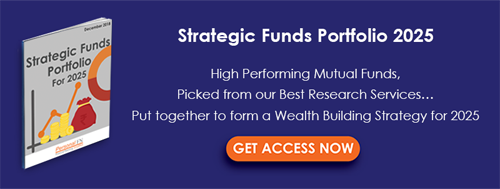It’s surprising to see that equity markets aren’t perturbed with BJP losing three state assembly elections, nor are they concerned about Dr Urjit Patel’s resignation. Perhaps, market participants believe that people will vote at the Lok Sabha elections 2019 differently and Mr Shaktikanta Das—the newly appointed RBI governor—would save the central bank’s autonomy and improve its dialogue with the government.
[Read: Should You Alter Your Mutual Fund Portfolio Based on the Election Results?]
Moreover, positive global cues viz. falling crude oil prices and easing trade war tensions between the U.S. and China are also proving supportive for the Indian markets.
In just two trading sessions following the poll results and despite Dr Patel’s resignation, the S&P BSE Sensex has jumped 5% so far from the December lows. However, many mutual fund investors are curious to know how durable the current market rally is and how they should approach their investments.
First, let’s see the reason why the market is rallying:
The newly appointed RBI Governor, Mr Das has served as an economic affairs secretary in the Modi administration for two years. He’s considered to be a blue-eyed bureaucrat of the Modi government (despite having served some key positions under UPA regime). He has played an instrumental role in implementing demonetisation.
Mr Das is believed to be more open to the government’s role in RBI’s affairs. Soon after taking over the charge as the governor of RBI, Mr Das assured that he would try his best to maintain the credibility of RBI and preserve its autonomy.
Post his appointment, many investors are hoping to see a change in RBI’s monetary policy stance from neutral to accommodative in 2019.
Retail inflation (measured by the Consumer Price Index) for November softened to 2.3% —the lowest in 16 months. This may provide some room to the RBI. In his first press address, Mr Das clarified that along with inflation targeting; economic growth remains an important policy objective.
But in the 5th Bi-monthly monetary policy review statement for 2018-19, has cited that the inflation outlook is clouded by several uncertainties:
-
Measures aimed at ensuring remunerative prices to farmers for their produce (in the form of higher MSP).
-
Oil prices remain vulnerable to further upside pressures, especially if the response of oil-producing nations to supply disruptions from geopolitical tensions is not adequate.
-
Volatility in global financial markets continues to impart uncertainty to the inflation outlook.
-
A sharp rise in input costs, combined with rising pricing power, poses the risk of higher pass-through to retail prices for both goods and services. However, the central bank has observed that the global commodity prices other than oil have moderated, which should mitigate the adverse influence on input costs.
-
Should there be fiscal slippage at the centre and/or state levels, it will have a bearing on the inflation outlook, besides heightening market volatility and crowding out private sector investment.
-
And finally, the staggered impact of HRA revision by the state governments may push up headline inflation.
Besides, Mr Das also has a number of issues to address without wasting much time. These include:
-
Relaxation of prompt corrective action (PCA) norms for banks
-
Special liquidity window for Non-Banking Financial Companies (NBFCs)
-
Dilution of Basel-III norms for Indian banks
-
Government seeking higher payouts from RBI
Resolving these issues is tougher than taking a monetary policy stance.
The former RBI governor, Dr Raghuram Rajan, had warned the government against the adverse effects of forcing RBI to capitalise Public Sector Banks (PSUs) when he was in service. At an Assocham event he had cautioned saying,
‘The Economic Survey has suggested the RBI should capitalize public sector banks. This seems a non-transparent way of proceeding, getting the banking regulator once again into the business of owning banks, with attendant conflicts of interest’.
Recently, Deputy Governor of RBI, Dr Viral Acharya, has already underscored the potential consequences of not respecting central bank’s autonomy.
‘Far-sighted government leaders may be able to reap benefits of convincing voters about the importance of investing in macro-economic stability; for instance, by claiming credit for the long-term nature of financial sector outcomes attained by allowing the central bank autonomy in decision-making and delivery of its core functions.
When such a measured perspective of an independent central bank as a key element of durable economic prosperity is missing and/or government myopia so rife as to lead to regular inroads into central banking apparatus and decisions, unfortunate accidents can arise.
Macroeconomic management can become a tug of war between securing stability and inflicting misdirection; daily operational decisions lead to power struggles; and, as the central bank is forced to bend over backwards to retain credibility in the face of imminent pressures that would erode its independence, counter efforts to reduce its independence escalate.
As this dynamic plays out, markets watch keenly, and if uncertainty grows and confidence in central bank independence and credibility erode, then markets rap bond yields and exchange rate on the knuckles!’
As an investor, you must have realised how volatile markets may become if the RBI governor fails to walk the talk and the government demolishes RBI’s autonomy.

(Image source: unsplash.com)
How should you approach your mutual fund investments now?
If go with the market momentum and commit more money to markets at this juncture, you might have to repent later.
The basic market assumptions that are driving Indian equities for now might go wrong over next few months.
If NDA loses the Lok Sabha elections and Mr Das’s appointment fails to play the role of icebreaker, market bulls might fall flat on their faces.
Creating an all-weather portfolio is a must!
[Read: Why You Need An All-Weather Mutual Fund Portfolio]
So you need to design your portfolio of equity-oriented mutual fund schemes in such a way that it makes the most of market volatility.
Have you heard of the ‘core and satellite’ strategy of investing?
What’s so unique about this? Good question.
This strategy aims to get the best of both worlds, that is, short-term high-rewarding opportunities and long-term steady-return investing, and the good thing is, it works!
The term "core" applies to the more stable, long-term holdings of the portfolio, while the term "satellite" applies to the strategic portion that would help push up the overall returns of the portfolio across market conditions.
The benefits of following the core and satellite approach are:
-
Facilitates optimal diversification;
-
Reduces the risk to your portfolio;
-
Enables you to benefit from a variety of investment strategies;
-
Aims to create wealth, cushioning the downside;
-
Offers the potential to outperform the market; and
-
Reduces the need for constant churning
The ‘Core and satellite’ investing is a time-tested strategic way to structure and/or restructure your investment portfolio. As far as your mutual fund investments are concerned, the ‘core portfolio’ should consist of large-cap, multi-cap, and value style funds, while the ‘satellite portfolio’ should include funds from the mid-and-small cap category and opportunities style funds.
PersonalFN’s research states that 60% of the portfolio shall be reserved for Core mutual funds and the rest 40% for the Satellite mutual funds.
But what matters the most is the art of astutely structuring the portfolio by assigning weightages to each category of mutual funds and the schemes picked for the portfolio.
Moreover, with changes in market outlook, the allocation/weightage to each of the schemes, especially in the satellite portfolio, needs to change.
Please remember:
Constructing a portfolio with a stable core of long-term investments and a periphery of more specialist or shorter-term holdings can help to deliver the benefits of asset allocation and offer the potential to outperform the market. The satellite portfolio provides the opportunity to support the core by taking active calls determined by extensive research.
PS: PersonalFN offers you a great opportunity if you’re looking for “high investment gains at relatively moderate risk”. Based on the ‘core and satellite’ approach to investing, here’s PersonalFN’s premium report: The Strategic Funds Portfolio For 2025 (2019 Edition).
In this report, PersonalFN will provide you with a ready-made portfolio of its top equity mutual funds schemes for 2025 that have the ability to generate lucrative returns over the long term. Subscribe now!

Add Comments